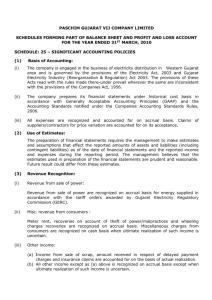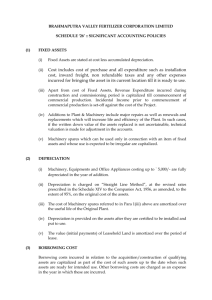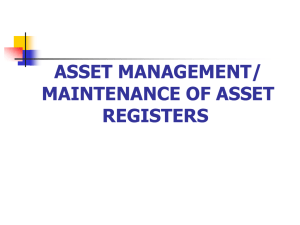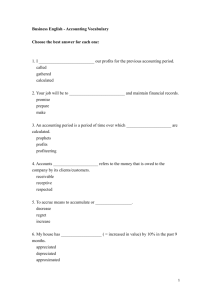J - Delhi
advertisement
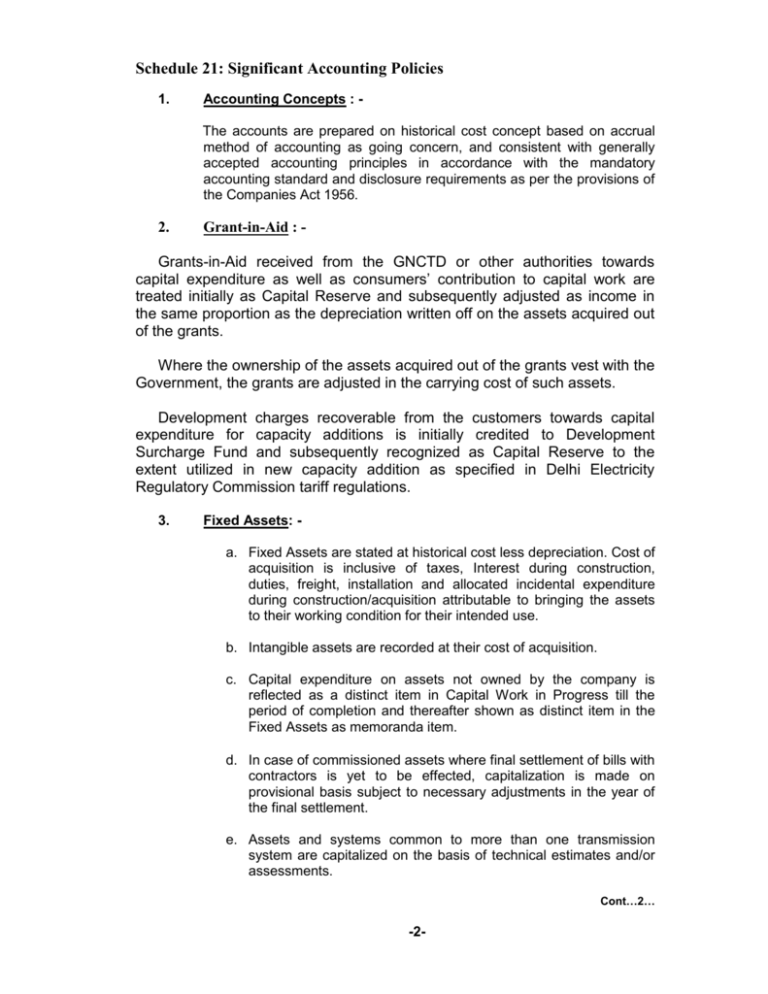
Schedule 21: Significant Accounting Policies 1. Accounting Concepts : The accounts are prepared on historical cost concept based on accrual method of accounting as going concern, and consistent with generally accepted accounting principles in accordance with the mandatory accounting standard and disclosure requirements as per the provisions of the Companies Act 1956. 2. Grant-in-Aid : - Grants-in-Aid received from the GNCTD or other authorities towards capital expenditure as well as consumers’ contribution to capital work are treated initially as Capital Reserve and subsequently adjusted as income in the same proportion as the depreciation written off on the assets acquired out of the grants. Where the ownership of the assets acquired out of the grants vest with the Government, the grants are adjusted in the carrying cost of such assets. Development charges recoverable from the customers towards capital expenditure for capacity additions is initially credited to Development Surcharge Fund and subsequently recognized as Capital Reserve to the extent utilized in new capacity addition as specified in Delhi Electricity Regulatory Commission tariff regulations. 3. Fixed Assets: a. Fixed Assets are stated at historical cost less depreciation. Cost of acquisition is inclusive of taxes, Interest during construction, duties, freight, installation and allocated incidental expenditure during construction/acquisition attributable to bringing the assets to their working condition for their intended use. b. Intangible assets are recorded at their cost of acquisition. c. Capital expenditure on assets not owned by the company is reflected as a distinct item in Capital Work in Progress till the period of completion and thereafter shown as distinct item in the Fixed Assets as memoranda item. d. In case of commissioned assets where final settlement of bills with contractors is yet to be effected, capitalization is made on provisional basis subject to necessary adjustments in the year of the final settlement. e. Assets and systems common to more than one transmission system are capitalized on the basis of technical estimates and/or assessments. Cont…2… -2- 4. Depreciation: 4.1 Depreciation on Fixed Assets is provided on straight line method in terms of rates specified in Schedule XIV of the Companies Act 1956 except that computers acquired are depreciated at the rate of 33.40% per annum. 4.2 Assets costing up to Rs. 5000/- are fully depreciated in the year in which they are put to use. 4.3 Depreciation on addition to/deductions from fixed assets during the year is charged on pro-rata basis from/up to the month in which the asset is available for use/disposal. 4.4 Where the cost of depreciable assets has undergone a change during the year due to increase/decrease in long term liabilities on account of exchange fluctuation, price adjustment, change in duties or similar factors, the unamortized balance of such assets is adjusted for such change and depreciated prospectively over the residual life determined on the basis of the rate of depreciation. 4.5 Computer software recognized as intangible asset is amortized on straight line method over a period of 3 years. 4.6 Depreciation charged on an asset shall cease from the year following the year in which:the year’s depreciation along with the depreciation charged in the previous year(s) becomes equal to or more than 95 % of the cost of the asset, or i. ii the asset permanently ceases to be used by the company whichever is earlier. 4.7 Leasehold buildings are amortized over the lease period or 30 years whichever is lower. Leasehold land and buildings, whose lease period is yet to be finalized, are amortized over a period of 30 years. 4.8 Capital expenditure on Temporary Structural or assets not owned by the Company is reflected as a distinct item in Capital Work-inProgress till the time of completion and thereafter shown as distinct item in fixed assets and charged to Revenue as 100% depreciable assets. 5 Capital Work-in-Progress: 5.1 Treatment of Borrowing cost during construction: Borrowing costs (net of interest earned on temporary investments of such borrowings) if specifically attributable to qualifying assets, are capitalized to such assets and in general, weighted average interest cost is capitalized to the qualifying assets. Cont…3… -3- 5.2 Incidental Expenditure during Construction (net) including corporate office expenses (allocated to the schemes pro-rata to the annual capital expenditure) for the year, is apportioned to Capital Work-inProgress on the basis of accretions thereto. 5.3 The transmission system is capitalized when it is ready for intended use. However, in case of delay in commercial operation/earning of revenue, the Revenue Expenditure (excluding interest charges) incurred during the Intervening period are treated as Deferred Revenue Expenditure and amortized over a period of 5 years from the year of commercial operation/earning of Revenue. The depreciation charge is postponed till the year of commercial operation. 5.4 Deposit works/cost-plus contracts are accounted for on the basis of statement of accounts received from the contractors. 5.5 Claims for price-variation / exchange rate variation in case of contracts are accounted for on acceptance. 5.6 The value of material issued to the contractor and not utilized at construction site is charged to Capital Work-in-Progress. 5.7 The cost of advertisement for the purpose of tenders relating to various CWIP is also debited to the cost of capital works as an incidental expenditure thereto and the cost of advertisement of O&M works is charged to revenue account directly. 6. Mandatory spares and Insured Spares : Mandatory spares in the nature of sub-station equipment /capital spares i.e. stand by/service/rotational equipment and unit assemblies, either procured along with the equipment, are capitalized and depreciated as per relevant rates. Mandatory spares of consumable nature and transmission line are treated as inventory after commissioning of the line. Insured Spares purchased along with fixed assets are capitalized and depreciated along with the spares. Spares purchased subsequent to the commissioning of the fixed assets which can be used only in connection with an item of fixed assets and whose usage is expected to be irregular are charged off over the residuary useful life of the asset. 7. Foreign Currency Transactions : - 7.1 TRANSLATION CURRENCIES OF FINANCIAL STATEMENTS IN FOREIGN 7.1.1. Items of income and expenditure except depreciation are translated at average rate for the year. Depreciation is converted at the rates adopted for the corresponding fixed assets. 7.1.2. Current assets and liabilities carrying monetary value are translated at the closing rates, and the fixed assets are translated at the rates in force when the transaction took place. Cont…4… -47.1.3. All translation differences are recognized as income/expense during the year in which they arise. 7.2 OTHER FOREIGN CURRENCY TRANSACTIONS 7.2.1 Foreign currency transactions are initially recorded at the rate of exchange ruling at the date of transaction. 7.2.2 Foreign currency loans/deposits/liabilities are reported with reference to the rates of exchange ruling at the year- end and the difference resulting from such translation as well as due to payment/discharge of liabilities in foreign currency related to Fixed Assets/Capital Work in Progress is adjusted in their carrying cost and that related to current assets is recognized as revenue/expenditure during the year. 8. Inventory valuation: Inventories of stores and spare parts and loose tools in stock are valued at cost, on weighted average basis. Construction Steel Scrap is valued at estimated realizable or book value whichever is less. Other Scrap is accounted for as and when sold. 9. Investments: Investments are carried at cost. Provision is made for diminution, other than temporary, in the value of such investments. 10. Accounting for Contracts: Income on contracts for construction, technical services related to construction of assets etc., is accounted for on “completed contract” basis and included in “other Income”. Expenditure incurred during pendency of contracts is carried forward as Work-in-Progress. 11. Prior period and extraordinary items: Prior Period and Extraordinary transactions are accounted in accordance with Accounting Standard-5. 12. Significant Events occurring after the Balance Sheet date: Treatment of contingencies and significant events are in accordance with Accounting Standard-4. 13. Revenue Recognition: a) Revenue recognition is in accordance with Accounting Standard-9. b) Transmission Income is accounted based on the tariff rates approved by the Delhi Electricity Regulatory Commission. Cont…5… -5- 14. 15. c) The incentives/disincentives are accounted for based on the norms notified/approved by the Delhi Electricity Regulatory Commission or agreements with the beneficiaries. d) The surcharge on late payment/overdue sundry debtors for sale of energy is not treated accrued due to uncertainty of its realization and is, therefore, accounted for on receipt. e) Interest/Surcharge recoverable on advances to suppliers as well as warranty claims/liquidated damages are not treated accrued due to uncertainty of realization/acceptance and are, therefore, accounted for on receipt/ acceptances. f) Scrap other than construction steel scrap is accounted for in the accounts as and when sold. g) In respect of agreements for sale of power/wheeling charges which are pending execution/renewal, income is recognized based on intimation issued by DERC until issue of notification of revised tariff. h) Insurance claims for loss of profit are accounted for in the year of acceptance other insurance claims are accounted for based on certainty of realization. i) The income or expenditure as the case may be on account of revision in tariff is done on the basis of orders of DERC/CERC. Expenditure: a) Expenses on training, recruitment and research and development are charged to revenue in the year of incidence. b) Prepaid expenses and prior period expenses / income of items of Rs 25,000/- and below are charged to natural heads of accounts. c) Expenditure on Leave Travel Concession to employees is recognized in the year of availment due to uncertainty in accrual. d) Machinery spares which can be used only in connection with an item of fixed asset and whose use is expected to be irregular are capitalized and depreciated over the residual useful life of the related plant and machinery and other are charged to expenditure. Segment Reporting: The accounting policies adopted for segment reporting are in line with the accounting policy of the Company. Revenue and expenses have been identified to segments on the basis of their relationship to the geographical location of the segment. Revenues and expenses, which are not allocable to segments on a reasonable basis, have been included under "Unallocable Expenses". Cont…6… -616. Taxes on income: Current tax is determined as the amount of tax payable in respect of taxable income for the year. Deferred tax is recognized on timing difference; being the difference between taxable income and accounting income that originate in one period and are capable of reversal in one or more subsequent periods. Where there is unabsorbed depreciation or carry forward losses, deferred tax asset are recognized only if there is virtual certainty of realization of such assets. Other deferred tax assets are recognized only to the extent there is reasonable certainty of realization in future. 17. Employee Benefits: The employee benefits are accounted for as per the provisions of AS 15 on the basis of categories in which the employees are covered namely defined contribution plan & defined benefits plan. The employees in the employment before the unbundling period is covered under the defined benefits plan to be paid by Pension Trust and other employees are to be paid for the post retirement benefits by company only. In respect of benefits covered under the defined contribution plan namely the provident fund, the employer contribution paid with the PF commissioner is recognized as the expenditure of the year. In respect of the benefits covered under the defined benefit plan namely pension, gratuity, leave encashment etc, the expenditure is recognized on the basis of present value of obligations as on the date of balance sheet as per the actuarial valuation. 18. Preliminary expenses shall be written off over a period of 5 years by transferring 1/5th to the Profit & Loss A/c every year. 19. Contingent Reserve: Contingent reserve has been provided @ 0.25% on the Gross Block of Fixed Assets to the extent of maximum of 5% of the Gross Block up-to the year 2005-06 however as per the order of DERC for tariff for the 2006-07, There is no need to provide for the same from the year 2005-06 onwards in view of the repeal of Electricity Supply Act 1948 by Electricity Supply Act 2003. However as per the same order the contingency reserve created by company up-to 2004-05 shall be dealt with separately.

